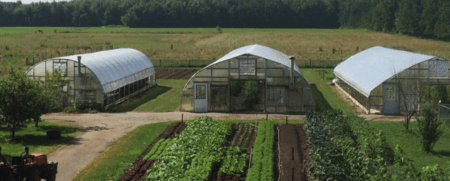Clay Bottom Farm
Ben Hartman and Rachel Hershberger
Goshen, IN
SNAPSHOT QUESTIONS
When did you start your farm?
2006. We farmed part-time, relying on off farm income, until 2011. Since then we’ve farmed full-time for a living.
What do you produce?
Produce, with a focus on greens.
How big is your farm?
We have less than one acre in production (we own five acres), with 9,000 square feet under four greenhouses. We have 35 CSA customers, which represents 1/3 of our business. We also sell to restaurants and at a farmers market.
Where is it?
Goshen, Indiana. About midway between Detroit and Chicago.
What is your soil type and topography?
Very heavy clay.
Do you lease, rent or own your land?
Own.
What are your markets?
CSA, six restaurants, one farmers market.
IN-DEPTH QUESTIONS
What made you want to start your farm? What was your dream?
My wife and I wanted to stay home and make a living from our own land.
How were you involved in farming before you started your own farm?
I grew up on a 450-acre corn and soybean farm. For four years after college I worked for a baby greens farm in Southern Michigan. We delivered to high-end Chicago restaurants.
How did you secure land and capital for your farm?
For eight years after graduating from college, my wife and I worked (construction, farm labor, teaching, odd jobs) and saved our money. We likely banked more than half our earnings every year. This gave us a chunky down payment for our farm and gave us start-up cash. We will pay off the rest of the farm in 2016 using income from the farm.
What problems did you run into in the planning stages?
Difficult to find good land close to our urban markets.
What did your farm look like in year one?
¼ acre on rented land with 12 CSA customers. That was the perfect size to start out.
What were some challenges that you didn’t expect to have and how did you deal with them?
Finding time to both grow and sell. Eventually, we created a part-time marketing manager position that we hired out. That person delivers to our restaurants, takes our food to farmers markets — basically does our selling and marketing so we can stay on the farm and grow more food.
What were some indicators in the beginning stages that made you optimistic for your farm’s success?
When we started to get return customers in years two and three.
What have been some landmark events in your farm’s development? (equipment purchases, strategic decision, markets, etc.)
We started out trying to grow everything for everyone. After a few years, we contracted our business by cutting out our least profitable crops and we limited our markets to those closest to home. Now we grow just 30 crops (not 80) and 90% of our food ends up on plates within 10 miles of the farm. Our ruthless focus on growing only the most profitable crops and selling only to the easiest outlets is how we are able to make a comfortable living on less than an acre of land.
Was there a point when you felt your farm became “established?”
One day last year I received letter from the Kubota corporation in the mail declaring that my tractor was now paid off. The Kubota was our last major infrastructure piece that we still owed on. That was one point when I felt established.
How have your goals changed?
A major goal for us now is to keep our income level steady while keeping our workload under 40 hours/week, every week.
How have you been successful? (financial, production, quality of life, etc.)
Success for me is more than financial. Success means paying our bills with our food, but also building a work environment that is clean, organized, predictable, relaxing, and fun to be in — for me and other workers. I feel we are also successful when we finish a year with energy rather than burned out.
Who or what can you credit for your successes?
The lean system — cutting out waste, getting organized, and focusing on value — turned things around for us.
What challenges does your farm face now and in the future?
Global weirding is a huge threat.
Where do you see your farm in five years?
We are always searching for ways to replace less profitable crops with more profitable ones. Recently, we’ve been excited about results from fig and ginger trials.
What advice would you give to beginning farmers?
I was talking recently with my friends at Blue Heron Farm about what it takes to make a go of it in farming. Our conclusion is that you need two of the following three things before you will start to make money:
1. $60K in start-up capital (for tractors, trucks, wagons, greenhouses, fences… your basic set-up).
2. Access to land — family land, land you’ve bought, inherited land, whatever.
3. Eight years of experience.
Two notes about point #3:
• Eight years is not unreasonable. That’s what it takes for doctors and plumbers, too, and farming is at least as complicated. • The “experience” we’re talking about involves actual work, where your hands get dirty. Farming is a
• The “experience” we’re talking about involves actual work, where your hands get dirty. Farming is a blue collar job, like plumbing, where you shower after you get home from work, not before.
More on Clay Bottom Farm:
http://www.claybottomfarm.com
And Ben’s book, The Lean Farm:
http://www.chelseagreen.com/the-lean-farm
Originally published on March 15, 2016



















